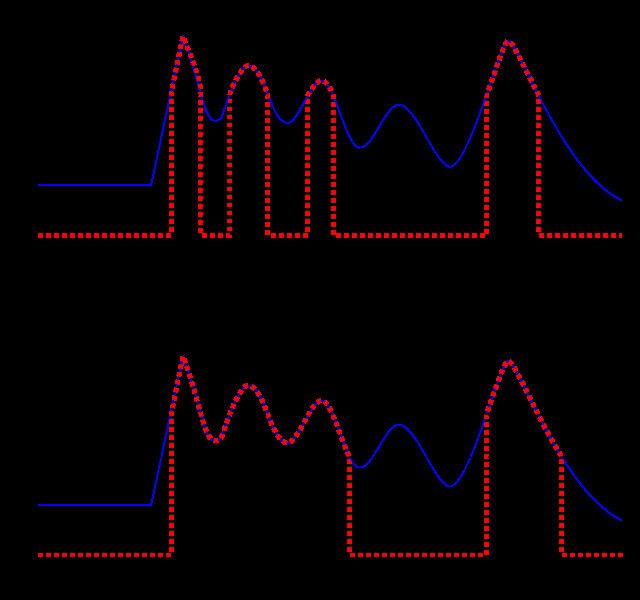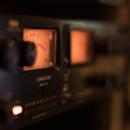Hola, últimamente he estado aprendiendo sobre procesamiento digital de señales leyendo un libro llamado The dance music manual y habla sobre la histéresis, pero no he podido entender bien lo que dice:
En inglés es así:
NOISE GATES
Noise gates can be described as the opposite of compressors. This is because while a compressor attenuates the level of any signal that exceeds the threshold, a gate can attenuate or remove any signals that are below the threshold. The main purpose of this is to remove any low-level noise that may be present during a silent passage. For instance, a typical effect of many commercial dance tracks is to introduce absolute silence or perhaps a drum kick just before the reprise so that when the track returns fully, the sudden change from almost nothing into everything playing at once creates a massive impact. The problem with this approach, though, is that if there is some low-level noise in the recording it will be evident when the track falls silent (i.e. noise between the kicks), which not only sounds cheap but reduces the impact when the rest of the instruments jump back in. In these instances, by employing a gate it can be set so that whenever sounds fall below its threshold the gate activates and creates absolute silence. While in theory this sounds simple enough, in practice it’s all a little more difficult.
Firstly, we need to consider that not all sounds stay at a constant volume throughout their period. Indeed, some sounds can fluctuate wildly in volume, which means that they may constantly jump above and below the threshold of the gate. What’s more, if the sound was close to the gates threshold throughout, with even a slight fluctuation in volume it’ll constantly leap above and below the threshold resulting in an effect known as chattering. To prevent this, gates will often feature an automated or user-definable hold time. Using this, the gate can be forced to wait for a predetermined amount of time after the signal has fallen below the threshold before it begins its release stage, thus avoiding the problem.
The action of this hold function is sometimes confused with a similar gate process called hysteresis but the two processes, while accomplishing the same goal, are very different. Whereas the hold function forces the gate to wait for a predefined amount of time before closing, hysteresis adjusts the threshold ’s tolerance independently for opening and closing the gate. For example, if the threshold was set at, say, 12 dB, the audio signal must breach this before the gate opens but
the signal must fall a few extra dB below 12 dB before the gate closes again. Consequently, while both hold and hysteresis accomplish the same goal in preventing
any chatter, it is generally accepted that hysteresis sounds much more natural than simply using a hold control.
Yo lo traduje así:
NOISE GATES (PUERTAS DE RUIDO)
Las puertas de ruido pueden ser descritas como lo opuesto de un compresor. Esto es porque mientras un compresor atenúa cualquier señal que excede el threshold, una puerta de ruido atenúa o remueve cualquier señal que esté debajo del threshold. El propósito principal de un gate es remover cualquier ruido de poco volumen que pueda estar presente en el pasaje silencioso de una canción. Por ejemplo, un efecto típico en muchas canciones de música electrónica comercial es introducir un silencio absoluto, así que cuando la canción vuelve a su climax, el cambio repentino de casi nada a “todo sonando a la vez” creará un fuerte impacto en el oyente. El problema con esto es que si hubiera un ruido de poco volumen en la grabación este problema sería evidente cuando la canción esté en silencio, lo que no solamente sonará poco profesional, también se reducirá el impacto de la canción cuando los demás instrumentos vuelvan. En este tipo de situaciones, con el uso de un gate es posible configurar los parámetros para que cualquier sonido debajo del threshold active el gate y aplique un silencio absoluto. Mientras que en teoría suena simple, en la práctica es un poco más complicado.
Primero, se necesita considerar que no todos los sonidos tienen un volumen constante durante todo el periodo de tiempo. De hecho, algunos sonidos pueden cambiar dramáticamente su volumen, lo que quiere decir que pueden constantemente saltar sobre y debajo del threshold fijado en el gate haciendo abrir y cerrar el gate respectivamente. Es más, si el sonido en cuestión está cerca del threshold entonces con incluso una pequeña fluctuación en el volumen, la señal constantemente se moverá sobre y bajo el threshold, dando como resultado un efecto conocido como “chattering”. Para prevenir esto, los gates a menudo cuentan con un parámetro llamado “hold time” automatizado y que puede ajustar el usuario. Usando esto, el gate puede ser forzado a esperar una determinada cantidad de tiempo después de que la señal haya caído debajo del threshold para que luego comenzar con su etapa de release, y de esta forma evitar el problema.
La forma de actuar del parámetro hold es a veces confundido con un proceso similar llamado histéresis, y aunque los dos procesos tienen el objetivo de eliminar el “chattering ”, sus formas de funcionar son muy diferentes. Mientras que la función de hold hace forzar al gate a esperar una cantidad predefinida de tiempo antes de cerrarse, la histéresis ajusta la tolerancia del threshold independientemente de que el gate esté abierto o cerrado. Por ejemplo, si el threshold fue ajustado por decir, a -12 dB la señal de audio no debe de sobrepasar esto antes de que el gate se abra pero la señal debe caer unos -12 dB extra antes de que el gate se cierre de nuevo. A pesar de que el hold y la histéresis comparten el mismo objetivo de prevenir el “chattering”, el sonido procesado usando la histéresis suena mucho más natural que el de simplemente usar el control de hold.
Además tengo pensado traducir el libro completo, así que quería saber en profundidad qué es la histéresis para saber lo que estoy traduciendo.
En inglés es así:
NOISE GATES
Noise gates can be described as the opposite of compressors. This is because while a compressor attenuates the level of any signal that exceeds the threshold, a gate can attenuate or remove any signals that are below the threshold. The main purpose of this is to remove any low-level noise that may be present during a silent passage. For instance, a typical effect of many commercial dance tracks is to introduce absolute silence or perhaps a drum kick just before the reprise so that when the track returns fully, the sudden change from almost nothing into everything playing at once creates a massive impact. The problem with this approach, though, is that if there is some low-level noise in the recording it will be evident when the track falls silent (i.e. noise between the kicks), which not only sounds cheap but reduces the impact when the rest of the instruments jump back in. In these instances, by employing a gate it can be set so that whenever sounds fall below its threshold the gate activates and creates absolute silence. While in theory this sounds simple enough, in practice it’s all a little more difficult.
Firstly, we need to consider that not all sounds stay at a constant volume throughout their period. Indeed, some sounds can fluctuate wildly in volume, which means that they may constantly jump above and below the threshold of the gate. What’s more, if the sound was close to the gates threshold throughout, with even a slight fluctuation in volume it’ll constantly leap above and below the threshold resulting in an effect known as chattering. To prevent this, gates will often feature an automated or user-definable hold time. Using this, the gate can be forced to wait for a predetermined amount of time after the signal has fallen below the threshold before it begins its release stage, thus avoiding the problem.
The action of this hold function is sometimes confused with a similar gate process called hysteresis but the two processes, while accomplishing the same goal, are very different. Whereas the hold function forces the gate to wait for a predefined amount of time before closing, hysteresis adjusts the threshold ’s tolerance independently for opening and closing the gate. For example, if the threshold was set at, say, 12 dB, the audio signal must breach this before the gate opens but
the signal must fall a few extra dB below 12 dB before the gate closes again. Consequently, while both hold and hysteresis accomplish the same goal in preventing
any chatter, it is generally accepted that hysteresis sounds much more natural than simply using a hold control.
Yo lo traduje así:
NOISE GATES (PUERTAS DE RUIDO)
Las puertas de ruido pueden ser descritas como lo opuesto de un compresor. Esto es porque mientras un compresor atenúa cualquier señal que excede el threshold, una puerta de ruido atenúa o remueve cualquier señal que esté debajo del threshold. El propósito principal de un gate es remover cualquier ruido de poco volumen que pueda estar presente en el pasaje silencioso de una canción. Por ejemplo, un efecto típico en muchas canciones de música electrónica comercial es introducir un silencio absoluto, así que cuando la canción vuelve a su climax, el cambio repentino de casi nada a “todo sonando a la vez” creará un fuerte impacto en el oyente. El problema con esto es que si hubiera un ruido de poco volumen en la grabación este problema sería evidente cuando la canción esté en silencio, lo que no solamente sonará poco profesional, también se reducirá el impacto de la canción cuando los demás instrumentos vuelvan. En este tipo de situaciones, con el uso de un gate es posible configurar los parámetros para que cualquier sonido debajo del threshold active el gate y aplique un silencio absoluto. Mientras que en teoría suena simple, en la práctica es un poco más complicado.
Primero, se necesita considerar que no todos los sonidos tienen un volumen constante durante todo el periodo de tiempo. De hecho, algunos sonidos pueden cambiar dramáticamente su volumen, lo que quiere decir que pueden constantemente saltar sobre y debajo del threshold fijado en el gate haciendo abrir y cerrar el gate respectivamente. Es más, si el sonido en cuestión está cerca del threshold entonces con incluso una pequeña fluctuación en el volumen, la señal constantemente se moverá sobre y bajo el threshold, dando como resultado un efecto conocido como “chattering”. Para prevenir esto, los gates a menudo cuentan con un parámetro llamado “hold time” automatizado y que puede ajustar el usuario. Usando esto, el gate puede ser forzado a esperar una determinada cantidad de tiempo después de que la señal haya caído debajo del threshold para que luego comenzar con su etapa de release, y de esta forma evitar el problema.
La forma de actuar del parámetro hold es a veces confundido con un proceso similar llamado histéresis, y aunque los dos procesos tienen el objetivo de eliminar el “chattering ”, sus formas de funcionar son muy diferentes. Mientras que la función de hold hace forzar al gate a esperar una cantidad predefinida de tiempo antes de cerrarse, la histéresis ajusta la tolerancia del threshold independientemente de que el gate esté abierto o cerrado. Por ejemplo, si el threshold fue ajustado por decir, a -12 dB la señal de audio no debe de sobrepasar esto antes de que el gate se abra pero la señal debe caer unos -12 dB extra antes de que el gate se cierre de nuevo. A pesar de que el hold y la histéresis comparten el mismo objetivo de prevenir el “chattering”, el sonido procesado usando la histéresis suena mucho más natural que el de simplemente usar el control de hold.
Además tengo pensado traducir el libro completo, así que quería saber en profundidad qué es la histéresis para saber lo que estoy traduciendo.







